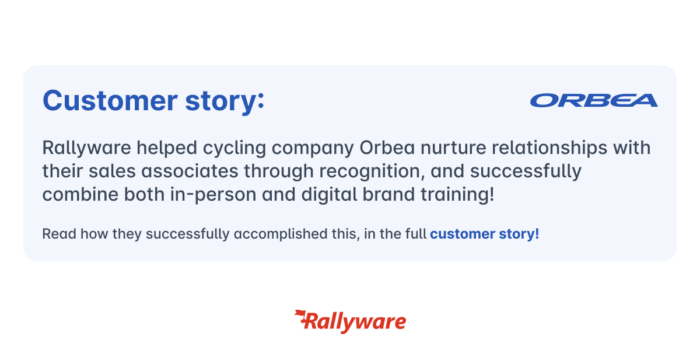Digital Strategy for Direct Selling: Paul Jones on Digital Transformation and Adaptability
Frontline Employee Training: Best Practices that Drive Customer Satisfaction
Frontline employees are the core of your business, from a customer service standpoint. They represent your product, services, and brand to the customers and ultimately influence customers’ satisfaction. Positive personal experiences drive most customers to make a purchase, tell their friends about the purchase and buy it again; but in the age of automation and social media experience sharing done at the speed of light, the personal touch of a shopping assistant matters more than ever. Heading into 2025, companies who pay close attention to their human capital and their pain points and have a customer-centric approach will be the most successful. Emphasizing comprehensive frontline employee training is critical for ensuring the success of new hires.
Download Rallyware’s Guide to Retail Empowerment for a shareable resource on frontline technology innovation and digital strategy for retailers.
Who are frontline employees, anyway?
Frontline employees, also known as front-line workers or frontline staff, are individuals who directly interact with customers, clients, or the public in various industries and sectors. They are the employees who directly represent and serve an organization’s customers or clients, often acting as the face of the company.
Frontline employees can be found in a wide range of industries, including retail, hospitality, healthcare, transportation, banking, customer service, and many others. Their roles may vary depending on the industry and specific job position, but they generally involve direct customer or client interactions.
Examples of frontline employees include:
- Retail sales associates who assist customers in stores
- Hotel staff who interact with guests
- Healthcare professionals who provide patient care directly or indirectly
- Customer service representatives who handle inquiries and resolve issues
- Bank tellers who assist customers with their financial transactions
Frontline employees are responsible for delivering positive customer experiences, resolving problems, and ensuring customer satisfaction, as well as (often) closing sales. As they have direct contact with customers, they often have valuable insights into customer preferences, concerns, and feedback, which can help improve products, services, and overall customer experience.
As further proof that the roles of frontline employees are vital, some CEOs are even temporarily stepping into frontline positions to get a closer look at the daily experience of these workers. For instance, new Starbucks CEO Laxman Narasimhan plans to spend a half a day each month working at different Starbucks locations, while Uber CEO Dara Khosrowshahi has spent time as an Uber driver himself.
As frontline employees are essentially the face of the company, it’s important for organizations to support and train them effectively to ensure they have the necessary skills, knowledge, and resources to successfully perform and succeed in their roles. After all, their contributions can significantly impact customer loyalty, brand reputation, and business success.
Differing approaches to frontline employee training
The old-school approach that connects employee engagement with customer satisfaction is known by every learning and development professional. A meta-analysis of 263 research studies states that businesses with the most engaged employees were 22% more profitable than those with the least engaged ones. Frontline employee training is a process that opens for employees a road to improved performance, career growth and, for businesses, a door to happy customers. But, in reality, frontline employees are often dissatisfied and disengaged, which directly influences the quality of customer service. So why is this happening?
- Rules are more important than service. Job rules aren’t applicable to different situations; they’re too narrow and strict, but following them is mandatory.
- Performance evaluation is based on time. The quality of frontline employees service is often measured by hours they’ve worked.
- Performance evaluation is based on the lack of mistakes. Managers want employees not to fail, but they don’t encourage them to improve.
These are the products of traditional leadership and corporate culture with poor attention given to employees: the power belongs to “the chosen ones,” and those who don’t have this power have to, you know, “do their job.” What are the typical mistakes in building a productive workplace for frontline employees that traditional leadership creates?
- The hiring process is based on “this person can do that job,” instead of “this person is right for that job.” Simply put, recruiters are looking for applicants who are looking for money.
- Frontline sales training is focused on the technical aspects of a certain position, rather than interacting with customers. Emotional labor isn’t recognized, and emotional intelligence isn’t trained.
- Lack of customer service training leads to the performing of repetitive tasks via scripts. It’s boring, and people quit often; thus, the turnover rate is high.
- A focus on operational efficiency without any personal touch doesn’t attract clients, because the quality of a product is just a basic value that can be satisfied anywhere.
- Additionally, lack of consistency in the operational guidelines, whereby management is constantly coming up with new ideas, may be confusing for some.
All of these points result from misconceptions or incorrect approaches to leadership, frontline employee training, and marketing. Dissatisfied frontline employees create dissatisfied customers—customers who refuse to use the services or products of such business, causing loss of profits. Dissatisfied employees quit their jobs, the turnover rate becomes high, and spending resources on the constant renewal of staff is a loss of profits. Former frontline employees recount their boring and inflexible jobs to their friends and through social media, and businesses lose the potential to become attractive to new talent. And that’s a loss of profits, as well. So, how can we break this cycle?
Hire the right people for the frontline

As we can see here, businesses often don’t put enough effort into the recruiting process for frontline positions—while people in those positions are crucial to vital business-customer interactions.
So, how do you hire the right people for these vital positions?
Look for emotional intelligence.
Emotions are a core part of humans’ interactions with their environment and each other. A study by neuroscientist Antonio Damasio showed that contrary to the popular belief that emotional people couldn’t make rational decisions, emotions are key to our decision-making process. He found that people who’ve injured the part of the brain responsible for emotions couldn’t make a rational decision. Ironically, there’s no critical thinking without emotions. So while hiring, look not only for technical skills but also for elements of emotional intelligence, such as empathy and patience, the ability to recognize non-verbal communication and lead another person’s emotions. These will be core for interacting with customers.
Test for motivation.
Since motivation is a natural human ability to seek pleasure and avoid pain, every person has a “dominant” type, a force he or she is been driven by. You’ll need to know this to manage and train these people later. For example, high-performers usually use pain-based motivation: they are constantly aware and agile, effective and proactive in problem-solving and removing possible pains in customers and within the workplace. You can use that while assigning tasks and challenging them.
Of course, there’s very little chance for your applicants to devote themselves to selling clothes. Instead, look for matches in the high-level values: How do they build relationships with other people? Do they want to improve themselves? Share knowledge with others? Know more about other aspects of the business? Without common values, there will be no trust. Without trust, open conversation isn’t possible, and honest communication is key to building a healthy and productive corporate environment.
Frontline employee training program structure
From the beginning of the onboarding journey, employees who have already learned about your vision during the interview process should then apply your business values to every interaction with customers. Now would be a great time to introduce the frontline employee training platform you would use. The platform should be accessible from any device and integrate performance and operational data for a personalized learning experience.
- Core values. You’ve already figured that your new employees have the same goals and beliefs. Now you should continuously show them how to entice them into customer interactions.
- Product or service knowledge. Frontline employees should know every detail about your products or services, changes in assortments, and operational or production specifics. They should be able to explain the features and values of your product.
- Soft and hard skills. Technical competencies should be trained and upgraded constantly, and skill gaps defined and filled. Soft skills have constant room for improvement. Training that is designed for both emotional intelligence and empowered employees who are willing to deliver high performance will bring great value to your customer base.
- Sales training. Along with soft skills, your frontline employees should be well-versed in the main principles of marketing and sales to present your product or service to each customer individually.
- Seasonal and other campaigns. Marketing training is focused on seasonal promo activities such as Christmas sales, Halloween drink specials, new clothing lines for summer and other marketing campaigns, promoting new features or services, the opening of a new department, a brand’s anniversary and more. These events are of different value propositions and require specific language and skills from frontline employees. With hands-on frontline employee training, store assocaites can learn all the necessary details on the spot and apply it right away, without an interruption to their job duties.
Frontline learning and development: living through a customer journey
The main goal of frontline employee training is for them to understand the customer journey. Customers expect personalized treatment as well as products and services best suited to their needs. They are ready to abandon their shopping journey after just one poor experience. How can a learning and development strategy be built to teach frontline employees to recognize and address customer pain points and preferences?
Train emotional intelligence (EI). Jake Sorofman of Gartner says, “What’s important to remember is that customer journeys aren’t created; they’re discovered. When we try to create journeys, we fall into one of these two traps: we either hallucinate customer needs or throw away the customer experience playbook altogether and focus on the needs we know intimately: our own.” Emotionally intelligent people can recognize, adjust and distinguish their own emotions from the emotions of others. A frontline employee with a high EI level recognizes customers’ unspoken pains, their emotional and mental state, even their background. Research shows that an emotionally connected customer is likely to spend 46% more money on your products than one who isn’t. EI allows your frontline employees to establish that bond.
To develop emotional intelligence, a frontline employee training program needs to continuously train your workforce on how to acknowledge, differentiate and accept emotions, reflect on their origin and handle them as well as emotions of others. In training, you can use gamification to train employees on emotionally basic or difficult situations, have them resolve conflicts, support customers, provide services or products to “close” customer’s specific needs.
Frontline employees who pay such extraordinary attention to customers, those who would, for instance, give lollipops to several kids in a store while their parents are waiting for service, are people with high emotional intelligence. These small and simple gestures drive word-of-mouth marketing—your customers are talking about you.
Such employees always deliver personalized, empathetic customer service and are a great fit for any team.
Remember that language matters. Make sure your frontline employees understand the concept of positive language and know how to explain the core values and benefits of your product in a simple, customer-centric manner. For instance, some choose not to use the word “but”; others write extensive guidelines on using a combination of “felt,” “feel” and “found;” etc. The main point is that your frontline staff should know their product, technical and customer service vocabulary perfectly. For this purpose, use short training modules with knowledge reinforcement tools. Ensure that employees understand the fact that they have to be speaking the client’s language—clients don’t want a drill, they want to put a shelf on a wall.
Introduce customer journey analytics. The concepts of touchpoints (moments of customer-product interactions) and mapping customer experiences are widely used in talks about communication between frontline employees and customers. But for deep customer understanding, frontline employees have to understand that touchpoints by themselves don’t matter: what matters is the entire customer journey, which has all the touchpoints that are cross-connected and influence each other, creating a bigger picture of the customer experience. Share with them crucial customer analytics through short learning modules proposing employees to apply known data and their soft skills to resolve certain situations in the workplace.
Provide in-team collaboration through training. Even if you don’t use people analytics or any tools that collect data about your customers, you need to create a collaborative environment and establish a culture of sharing knowledge and observations. Within that culture, your employees will intercommunicate and improve customer experience in real-time through chats and forums, integrated into a training platform. This is their safe place where they can share stories and lessons learned. Make sure that leaders and frontline employees can seamlessly interact through it using both open and closed communities.
Keynote: manage and train with the frontline in mind

Properly built and structured frontline training is engaging, but without leaders who implement flexible learning and let employees focus on the improvement of their performance, it wouldn’t reach its full potential. So, here are a few quick tips for managers and leaders to empower their frontline employees:
Communicate with your frontline employees. Share with them organizational challenges; tell them about their performance and those of other departments. Make them a real part of the big team. Perhaps invite several of them to meetings with large vendors. This will give them a feeling that they belong and that you recognize their contribution to the business’s growth as an individual.
Deliver training based on performance data. Working hours do not determine the quality of performance. Track frontline teams’ performance by business outcomes—such as new clients, increased number of loyal retained customers, the increased amount spent per purchase. Guided by this data, your managers can generate achievement-oriented performance reviews while automatically delivering training based on each employee’s performance: they’ll recognize employees’ strength and open avenues for employees’ further development and career goals. Such analysis will encourage the frontline to improve; it will be a part of employee appreciation.
Implement an employee performance appreciation program. Feedback matters. It drives your employees to move forward, to better deliver and improve. So make sure the frontline hear that you’re monitoring their performance—and you know that they’re influencing the overall business results. In fact, the appreciation program can also be integrated into the PBT platform: in that case, you’ll get not only a smart way to deliver rewards and appreciation but also a place where employees can engage in a friendly competition. Also, make sure you recognize frontline employees’ emotional labor and show your appreciation for it.

Let them shape the way your business delivers customer experience. Employees often feel frustrated with strict rules at the workplace. Autonomy, on the other hand, drives engagement and, therefore, customers’ satisfaction. Make the rules flexible and value-oriented, so your customer service can become value-oriented, and your employees can apply gathered insights about customer behavior from the frontline—let them make decisions and own their responsibilities. At the same time, create a structured framework so that your workplace doesn’t turn into chaos and that you can still ensure your employees adhere to the brand’s vision and values.
Finally, during times of changes in the business—when you’re trying to handle digital disruption or introduce new services—make sure your frontline employees have the opportunity to lead the wave of transformation. Relying on their local experience in customer service and providing them with the right learning and development tools, you can streamline your evolution. As Bain Insights writes in their case study in Forbes: “Tell them, then coach them, then let them run.”
Frontline employees that have been strategically hired, properly trained and respectfully treated create great long-term values – among them, value for your customers and for your business, an improved employee experience, customer satisfaction and, therefore, growth in business KPIs.
To motivate and engage your workforce, you’ll need the right technology for frontline employee training – a platform using context and data to trigger the right activities at the right times for the right behaviors. Book your demo to see Rallyware in action or read more about our retail sales enablement solution!
News and Insights on Workforce Training & Engagement
We’re among top-notch eLearning and business engagement platforms recognized for effective training and talent development, helping to empower distributed workforces
Subscribe
